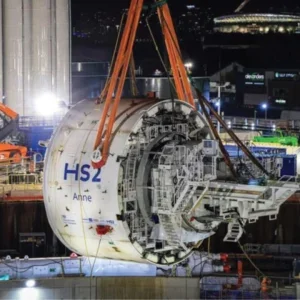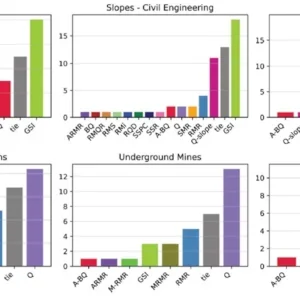Following the award of the Skempton Medal in 2018, David Hartwell offered to revisit his past experience and draw some lessons which might be of value to future projects.
Pumping tests are the most important tool for understanding the behaviour of groundwater. Pumping test procedures and the subsequent analyses are covered by various standards and texts. The object of a pumping test is to determine the shape and rate of development of the cone of influence when groundwater is abstracted from a well. Note that these tests are sometimes wrongly called pump tests – which is a test of a pump not of the groundwater!
The influence of pumping on the surrounding water levels or pressures requires the installation of monitoring points such as other wells, piezometers or standpipes. Historically everyone sat in a line with a manual dip meter measuring the change in water level with time in an observation well or standpipe. Often this was not particularly pleasant when conducted in mid winter or in summer in the Middle East. Now we generally use transducers but still need manual checks.
In 1972, his first pumping test, was for a water supply well in Braintree in Essex. The well was drilled into the Chalk aquifer which was confined by London Clay. Observation wells were drilled and an extra standpipe piezometer was installed in the confining clays. The reasons for this unconventional monitoring point have been lost in the mists of time.
The pumping test was conventional but the water level rose in the clay piezometer when the well was pumped. After checking, this was confirmed and further the water level fell when the pump was switched off! It turns out that this surprising phenomenon is known as the “Noordbergum Effect”. It was a fascinating introduction to the world of groundwater and the soil mechanics principle of effective stress.
Ringsend, Dublin 1977 Pumping Station Failure
A major pumping station was being excavated within a sheet pile cofferdam; the nominal diameter of the shaft was 30 metres and the depth 14 metres. The initial penetration of the sheet piles was 18 metres. An inflow developed near the toe of the wall when the excavation was within 800mm of target excavation depth.
The ground conditions comprised:
- Recent fill and Estuarine SILT
- SAND and GRAVEL with shells and cobbles
- Stiff Silty CLAY with irregular sand laminations
- Limestone
Ground conditions were complex but were dominated by the sand and gravel, probably connected to the nearby river and with a permeability of 10-3 m/sec or higher. Water pressures were hydrostatic throughout the sequence.
The sheet pile wall was intended to form a cut off being driven some five metres into the stiff clays. However the toe of the piles was only 2 – 3 metres below the formation level. A conventional flow net analysis looks uncomfortably close to being a problem, but is probably not relevant due to clay anisotropy.
The inflow developed at one particular location and reached about 30 l/sec of clean water. Gravel was dumped over the area to stabilise the flow. The subsequent events and completion of the pumping station are described by A.L. Little in the proceedings of the IX ECSMFE conference.
The cause of the initial failure has never been conclusively determined. Was heave due to water pressure trapped in laminations a significant factor? Was the penetration of the sheet piles inadequate as described above? What about a flow path created by the sheet piles; bent pile toe, cobble?
Two further cases were also cited where similar failure had occurred, these were:
The Olympic Cable Tunnel shafts in London in 2006 – Shafts to divert overhead power lines below the Olympic site were being constructed within a caisson then underpinned in the Chalk. Failure occurred in a similar manner to Ringsend.
Two shafts for stormwater diversion were being constructed in Preston in 2011 – Diaphragm walls toed into weak Sandstones were installed but failures occurred around the toe of the wall when excavation approached the target dig level.
Despite all three projects using different construction approaches there are common factors in all three failures:
Initial failures were around toe of the cut off via the shortest flow path and there was a source of high permeability gravels to feed initial failure.
Storebalt Eastern Railway Tunnels, Denmark 1991 -1994
The Storebælt Eastern railway tunnels formed the first fixed link connecting Danish islands, as such they were always a very high profile project attracting the attention of the local media. Further the project was always recognised as technically challenging.
The scheme comprised twin undersea tunnels, 8 kilometres long, up to 80 m below sea level, the outline and geology are shown in figure 1. Four 8.75 metre diameter EPB TBM’s were used at what was considered to be the then limit of TBM technology. The tunnel was lined with epoxy coated reinforced concrete segments with tapered rings to provide a watertight lining. In addition twenty nine cross passages had to be constructed between the tunnels outside the protection of the main tunnel lining.
The geology as indicated in figure 1 comprised glacial till overly marl – a weak calcareous permeable rock. The Till comprises a sequence of two depositional phases and is variable; the section shows a number of erosional features. The Till comprises 10 to 15% clay, 15 to 25% silt, 35 to 45% sand and up to 40% gravel as well as the occasional boulder up to 2 metres in diameter. These materials were inherently stable, presumably due to the clay content and formed near vertical cliffs along the coastline.
The Flooding Incident
In the early hours of Monday 14th October 1991 one of the tunnel faces collapsed and an inflow developed. The flow increased rapidly and reached 2 m3/sec – 2 tonnes of water per second.
The tunnel was evacuated; no one was injured. But the tunnel and the adjacent tunnel were completely flooded because the portals were below sea level.
The project was subjected to much media scrutiny and speculation. However with hindsight the following facts are considered relevant:
- The TBM had been stopped for critical mechanical repairs for 3 days,
- There was probably some relaxation of the exposed face which could have resulted in negative pore pressures developing, i.e. stable ground conditions,
- But any negative pore pressures would lead to very high hydraulic gradients locally, i.e. some flow of groundwater,
- Positive pore pressures would have at face restored dependent on permeability – Darcy’s Law,
- Presumably positive pore pressure could have led to a breakdown at face and erosion of low plasticity material eventually connecting to the sea?
Subsequent interventions typically only lasted about 3 days before instability was noted and the intervention abandoned.
Considering the above statements leads to a question regarding stand up time; this is a descriptive term, but can we relate it to permeability? The table below seeks to illustrate a possible relationship, assuming permeability is the key variable then stand up time is directly inversely proportional to permeability, i.e. the higher the permeability the quicker pore pressures re-establish following face relaxation.
The key example is probably the hole dug by a child on the beach, instability occurs after a few seconds when below the water table. Extending this to the Storebælt situation; at a permeability of 10-8 m/sec leads to a theoretical stand up time of 1.1 days. The relationship is obviously not precise but worthy of further consideration.
How to stabilise the ground whilst digging cross passages?
As noted above the cross passages had to be dug outside the safety of the main tunnel lining whilst continuing TBM mining at the same time. In addition the flooding incident made everyone profoundly aware of the inherent risks in hand dug excavations in highly variable glacial soils.
The options to obtain stable ground conditions included:
- Grouting? Grouting of soils with 10% clay is generally considered to be impractical. The technique was used in the marls for the deeper cross passages below the clay tills.
- Compressed Air? High pressures would be needed and establishing man locks whilst maintaining access to the TBM’s was considered impractical.
- Freezing? A recognised technique but time consuming and expensive. It was used locally where difficult conditions were recognised such as where there were sands in the crown of the cross passage.
- Depressurization and electro-osmosis? Reducing the moisture content was recognised as a route to controlling the ingress of water but drainage techniques were not well proven in this situation. Electro-osmosis was known to improve conditions but again unproven in this situation.
The drainage / depressurization option was favoured but a number of issues had to be addressed:
Firstly drilling into high pressure ground required careful management including blow out preventers. Then there were severe restrictions on angles and location due to durability issues; i.e. steel reinforcement to the segments in a saline environment. A highly efficient drill train was used which occupied one of the temporary tracks allowing the TBM to continue working via the second track.
With conventional drainage placing a granular filter around a wellscreen benefits from taking advantage of gravity but where horizontal and even upward drains are required gravity is an impediment. This problem was overcome by the use of a polymer suspension so that the filter could be pumped into place.
The spacing and idealized layout of the drains had to be determined. Two dimensional computer modelling of groundwater flow was undertaken. The object being to locate drains to intersect flow towards the excavation and not allow flow between the drains to meet excavation. The use of vacuum was assumed to increase the effectiveness.
The actual geometry of the drilled drains was another issue, it was not possible to drill parallel to the cross passage in the crown and invert due to geometric constraints. Therefore an angled solution was adopted and modified to optimise the drain spacing.
The question remained – would it work? A modified pumping test was undertaken using one of the first drains drilled and monitoring pressure using three “BAT” piezometers and another short drain. The results are shown on Figure 2. Initial pressure was below hydrostatic probably due to drilling operations. When the drain was opened and a small flow allowed a progressive decrease in pore pressure was observed in the monitoring points. After eight days the pore pressure had been reduced by about 50%.
The scheme was adopted for the till cross passages and was a success. Figure 3 shows the arrangement from the main tunnel. Multiple vacuum pumps can be seen and the hoses to individual drains. Note also the safety door considered obligatory after the earlier incident.
Project Moses
As part of the contingency measures a GBP 20M undersea dewatering scheme was developed. The objective was to reduce pore pressures in the marl underlying the tills to facilitate maintenance and interventions in the high water pressures zones that would encounter up to 8 bar pressure and generally assist by reducing pressures at the cross passages.
The origins of the name Moses derived from “Method of Safety by Emptying Storebælt”, a name that stuck once someone had thought of it.
A test well was drilled and a pumping test conducted; the result was encouraging; a drawdown of 1 metre was observed at 530m distance. In addition a flow log was undertaken that identified discrete flow zones and low permeability layers between, so that the conventional analysis that produced an average permeability of about 10 m/sec. was actually misleading and the actual conditions consisted of a few metres of very high permeability between extensive layers of very low permeability material.
A total of 49 wells were eventually drilled along with 12 piezometers. The pumps were powered from six barges and the water discharged at the seabed. The components of the scheme are shown on Figure 4. More than one million tonnes of water were pumped. The impact of the scheme can be seen on figure 1.
Docklands light railway tunnel, London. 1998
The Docklands Light Railway is a light rail scheme that has provided an efficient extension to the London subway system into the old dockland areas of East London which has become a key financial district. One part of the scheme extended southwards from Canary Wharf under the River Thanes to Greenwich.
On 23 January 1998 tunnels under the River Thames suffered a blow out during construction and one tunnel flooded. The cause of the blow out was the release of compressed air between two bulkheads some 400 metres part. The section of tunnel had been isolated and pressurized in order to construct a mid river sump and cross passage.
The Health and Safety Executive (HSE) were critical of the excess pressure that resulted near the shallowest bulkhead. Unfortunately this coincided with a school playground but fortunately the blow out occurred before school hours. With hindsight having the bulkheads so far apart resulted in the energy stored being very significant. Consider what happened when it was released, one comparison is what happens when a balloon is burst.
One lesson is clear, when using compressed air the volume under compression should be minimized. The tunnel had to be recovered and the cross passage and sump constructed in water bearing Thanet Sands with pressures up to 2.8 bar. Thanet Sands are a very dense sand but inherently unstable in the presence of water. Interestingly another flooding occurred from the Thanet Sands during construction of the London Water Ring Main flooding in 1989.
A freezing solution was studied in detail which involved 80 freeze pipes but required access from both tunnels but the flooded tunnel was not available initially. In addition, as at Storebælt, some of the freeze pipes were probably impractical to drill requiring a very acute angle in the crown of the main tunnel.
Drilling wellpoints from the tunnel, as at Storebælt, was even more onerous because of drilling into high pore pressure sands. The solution adopted was to use the relatively newly available wellscreens with very fine, 0.3mm wide, slots and developing a natural filter. Drilling was very challenging but the wellpoints after drilling immediately yielded a full bore flow of clear water. Eight wellpoints were drilled from the available main tunnel.
In addition eight wells were drilled from a jack up barge in the River to abstract water from the Chalk and drain the overlying Thanet Sands. These wells were similar to the Moses wells at Storebælt.
The final solution used was a combination of the two dewatering schemes and limited compressed air with a maximum pressure of 0.9 bar. The three independent components are important because as at Storebælt the failure of any one component must not result in a catastrophic flooding.
The programme described at the docklands light railway was successful, the tunnel recovered and the projected completed on programme.
Hartwell finished by saying “certain opinions expressed above may contravene old non disclosure type arrangements. I believe strongly that honest disclosure of facts when things have gone wrong is important for future engineers to learn from”.






